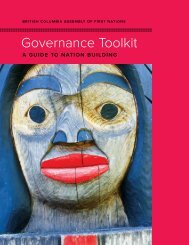program
program
program
Create successful ePaper yourself
Turn your PDF publications into a flip-book with our unique Google optimized e-Paper software.
11C Assembly of First Nations – Health Canada<br />
Biomonitoring Project<br />
Elsa La Corte, Assembly of First Nations<br />
The First Nations Biomonitoring Initiative - National Results is a<br />
national survey that collects information relevant to the health of<br />
First Nations people through questionnaires and direct physical<br />
measurements. The biomonitoring component examined the presence<br />
of 97 environmental chemicals that were selected based on<br />
considerations such as suspected health risks, level of public concern<br />
and comparability with other studies. These environmental chemicals<br />
were selected from a candidate list of over 200 individual chemicals<br />
and groups.<br />
Biomonitoring has become an essential tool in efforts to identify<br />
and control peoples’ exposure to environmental chemicals. Human<br />
biomonitoring is the measurement in people of a chemical, the<br />
products it makes after it has broken down or the products that might<br />
result from interactions in the body. Data can be used by scientists<br />
to assess if there are potential health risks from household and<br />
industrial chemicals present in an individual’s environment.<br />
12A House Insurance On Reserve<br />
Gil Saunders, Alliance First Nations Insurance Brokers<br />
Inc. and Doug Clarke, Capri Insurance Services Ltd.<br />
An outline of what to consider before making an insurance buying<br />
decision, factors that affect premium cost and how to mitigate these<br />
costs, whether for an individual’s policy or Community Housing.<br />
Claims process, Underwriting factors and Loss Prevention as<br />
they relate to availability and affordability of First Nation Housing<br />
Insurance.<br />
12B A Discussion on Providing Different Infrastructure<br />
Delivery Options<br />
Glen Ohs, Regional Manager, BC Coast, Corix Utilities, BC<br />
Operations<br />
Historically First Nations have not benefitted from the same degree of<br />
economic development opportunities, in their traditional territories, to<br />
the same degree as non-Aboriginal communities throughout the rest<br />
of Canada. Individual communities are diverse in nature, each having<br />
their own opportunities, challenges and constraints. Nonetheless they<br />
all share a common desire. A desire to share in the opportunities<br />
and create long-term well-paid employment for their young people. A<br />
multi-generational vision, that will result in careers not just short-term<br />
jobs. In order to achieve this objective of closing the socio-economic<br />
gap, we need to focus on finding a sustainable solution or approach<br />
for their communities. An approach that shares the generational<br />
view. A solution that can offer career paths not just jobs. A regional<br />
solution, owned by First Nations, operating in partnership for a longterm,<br />
cost-effective and sustainable solution. This regional solution<br />
promises to build long term local capacity not only with technical<br />
skills and business acumen but also provide financial stability for the<br />
First Nations now and in the future.<br />
12C OCWA’s Experience on the Hub Model for Operations of<br />
Water and Wastewater Facilities in Ontario<br />
Eric Nielson, Senior Operations Manager, Northeastern<br />
Ontario Hub, Ontario Clean Water Agency<br />
The presentation will consist of a description of the Hub model used<br />
by OCWA, and how it can be applied to First Nation facilities. We<br />
will talk about our training, our flexibility, how we help First Nation<br />
facilities operate under the guidance of strict water treatment<br />
regulations. We will touch on the essential importance of clean<br />
drinking water, and the importance of clean effluent water from<br />
sewage treatment plants.<br />
13A Shelter Allowance as it relates to Housing and the<br />
implementation of a Universal Rental Regime<br />
Donnie Garrow, Assembly of First Nations<br />
Shelter allowance, which is part of Income Assistance, has been a<br />
challenge to many communities especially in British Columbia, the<br />
Prairie and Atlantic provinces. This session will attempt to provide<br />
clarity on the situation surrounding Shelter Allowance and the<br />
requirement to implement Universal Rental Regime in the community.<br />
13B Affordable Homeownership and Building Skills with<br />
Habitat for Humanity<br />
Jay Thakar, Aboriginal Housing Program, Habitat for<br />
Humanity<br />
The Aboriginal Housing Program at Habitat provides Aboriginal<br />
families access to affordable homeownership in both urban areas as<br />
well as on Traditional Territories. The “Partnering Families” participate<br />
in building their home and enhance their home maintenance and<br />
financial management with Habitat. Over sixty Aboriginal families have<br />
realized their dream of homeownership with Habitat over the last five<br />
years. Let’s explore Habitat Partnership.<br />
February, 3–5, 2014<br />
21



